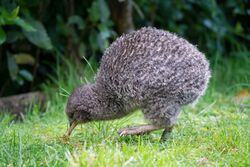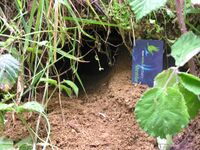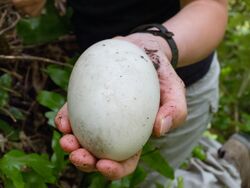Biology:Little spotted kiwi
| Little spotted kiwi | |
|---|---|

| |
| Foraging at Zealandia EcoSanctuary, Wellington | |
| Scientific classification | |
| Domain: | Eukaryota |
| Kingdom: | Animalia |
| Phylum: | Chordata |
| Class: | Aves |
| Infraclass: | Palaeognathae |
| Order: | Apterygiformes |
| Family: | Apterygidae |
| Genus: | Apteryx |
| Species: | A. owenii
|
| Binomial name | |
| Apteryx owenii | |
| Subspecies | |
| |

| |
| The distribution of little spotted kiwi.
Predator-free islands:
Mainland:
| |
| Synonyms | |
|
List
| |
The little spotted kiwi or little grey kiwi[2] (Apteryx owenii) is a small flightless bird in the kiwi family, Apterygidae. It is the smallest of the five kiwi species, at about 0.9 to 1.9 kg (2–4 1⁄4 lb), about the size of a bantam. It is endemic to New Zealand, and in pre-European times occurred in both main islands, but is now restricted to a number of small offshore islands, and mainland reserves protected by pest-exclusion fences. Little spotted kiwi (Apteryx owenii) was on the brink of extinction when a conservation effort took place 100 years ago. Five individuals were translocated from the South Island of New Zealand to Kapiti Island. Today, the Kapiti Island population has grown, with around 1200 birds.[5]
Taxonomy
The little spotted kiwi is a ratite and belongs to the Apterygiformes order, and the Apterygidae family. The genus name Apteryx means 'without wings' and the species is named owenii after Sir Richard Owen.[6] Only the nominate subspecies A. o. owenii survives. The subspecies A. o. iredalei from the North Island became extinct in the late 19th century;[7] its status as a subspecies is not universally accepted as valid though.[8]
The little spotted kiwi was first described in 1847 by John Gould from a specimen obtained by Frederick Strange and sent to England.[9] The locality is not recorded but it probably came from Nelson or Marlborough. In 1873, Henry Potts published an account of its habitats, and about this time specimens were collected in South Westland and sent to England.[2]
Description
The little spotted kiwi has a length of 35 to 45 cm (14–18 in) and the weight of the male is 0.88 to 1.36 kg (1 lb 15 oz–3 lb 0 oz) and the female weighs 1 to 1.95 kg (2 1⁄4–4 1⁄4 lb), making it the smallest species of kiwi.[8] Their feathers are pale-mottled grey, with fine white mottling, and are shaggy looking.[10][full citation needed] They lack aftershafts and barbules. They have large vibrissae feathers around the gape. They lack a tail, but have a small pygostyle.[2] Their bill is ivory and long and their legs are pale.[10]
The little spotted kiwi had an obligate louse that parasitized on it, Rallicola pilgrimi. In an example of conservation-induced extinction, all lice were killed while ensuring captive kiwis for survival.[11][12]
Distribution and habitat
Studies on Kapiti Island show that they prefer flax, seral, and older forest habitats. Lower numbers are found in rough grassland and scrub, indicating that either they prefer other habitats or they simply need a larger territory to support themselves in these areas.[10]
Behaviour
Little spotted kiwis eat grubs and other small insects that are found underground, and occasionally eat berries. Earthworms, cockchafer beetle larvae, caterpillars, cranefly larvae, and spiders are their most common foods.[13] Fruit of the hinau tree is also commonly consumed.[13] Annelids make up the largest percentage of the bird's diet.[13] Using its sharp talons and long beak, it digs into the ground and then shoves its long beak down the softened ground. As they cannot fly to get to insects or food on trees and their eyesight is very poor, they depend on a keen sense of smell, long beak and talons.[2] They are nocturnal. Little spotted kiwi call occasionally each night to advertise territory and to maintain contact with partners. Often pairs will duet. They are very territorial, and fight conspecifics with their sharp claws, resulting in many feathers on the ground.
Reproduction
They nest in an excavated burrow, dug by both birds and sometimes lined with plant material. Eggs are laid from July to January. The clutch size is one to two eggs (15% have 2), which are incubated by the male for 63–76 days. Chicks stay in the nest for 2–3 weeks after hatching and require feeding for 4 weeks.[2] Little spotted kiwi eggs are the largest egg relative to the size of the bird. Its egg accounts for 26 percent of its own weight—the equivalent of a human giving birth to a six-year-old child.
Conservation
At the time it was described, the species was common on the western side of the South Island and in Marlborough. Then a regular trade in skins sprang up and large numbers were collected for European museums. Further, with the advance of European settlement, birds were killed by prospectors and others for food and their attendant dogs and cats took their toll. The species was extinct on the North Island by 1938 when the last four South Island birds were moved from d'Urville Island to the population that had been established on Kapiti Island.[8] After they were released on Kapiti Island, they were also moved to Red Mercury Island, Hen Island, Tiritiri Matangi Island, Chalky Island, and Long Island in the Queen Charlotte Sound. In 2000, about 20 little spotted kiwis were released into Karori Wildlife Sanctuary. This was the first time since the 19th century that little spotted kiwis could be found on the mainland of the North Island.[10] In 2015, 20 kiwis were translocated from Kapiti Island to Anchor Island.
As the smallest species of kiwi, the little spotted kiwi would be very vulnerable to the main kiwi predators like cats, dogs, and stoats, however it is now restricted to several off-shore island reserves (mainly Kapiti Island) which are mostly free of introduced predators. The little spotted kiwi's conservation status is listed as "range restricted" (by 'Save the Kiwi'), with a growing population. Formerly classified as "vulnerable" by the IUCN,[14] it was suspected to be more numerous than generally assumed. Following the evaluation of its population size, this was found to be correct, and it was consequently downlisted to "near threatened" status in 2008 as, although not rare, its small range puts it at risk. The lack of predators, apart from weka (Gallirallus australis), is important to its increasing numbers. It has an occurrence range of 31 km2 (12 sq mi), and a population of 1600 was estimated in the year 2012.[1]
| Location | Population | Date | Trend |
|---|---|---|---|
| Hen Island | 50 | 2012 | Increasing |
| Kapiti Island | c.1200 | 2012 | Stable |
| Red Mercury Island | 70 | 2012 | Increasing |
| Long Island | 50 | 2012 | Increasing |
| Tiritiri Matangi | 80 | 2012 | Increasing |
| Zealandia Wildlife Sanctuary | 120 | 2012 | Increasing |
| Motuihe Island | 30 | 2012 | Stable |
| Anchor Island | 20 | 2015 | Increasing |
| Chalky Island | 50 | 2012 | Stable |
| Total (New Zealand) | 1670 | 2012 | Increasing |
Citations
- ↑ 1.0 1.1 BirdLife International (2016). "Apteryx owenii". IUCN Red List of Threatened Species 2016: e.T22678129A92756395. doi:10.2305/IUCN.UK.2016-3.RLTS.T22678129A92756395.en. https://www.iucnredlist.org/species/22678129/92756395. Retrieved 12 November 2021.
- ↑ 2.0 2.1 2.2 2.3 2.4 2.5 Davies, S. J. J. F. (2003)
- ↑ Gould, John (1847). "On a new species of Apteryx". Proceedings of the Zoological Society of London 15 (1): 93–94. doi:10.1111/j.1469-7998.1847.tb00159.x. https://www.biodiversitylibrary.org/page/12862877.
- ↑ Gill (2010). "Checklist of the birds of New Zealand, Norfolk and Macquarie Islands, and the Ross Dependency, Antarctica". Te Papa Press. http://nzbirdsonline.org.nz/sites/all/files/checklist/Checklist-of-Birds.pdf.
- ↑ Ramstad (2013). "Genetic consequences of a century of protection: serial founder events and survival of the little spotted kiwi (Apteryx owenii)". Proceedings. Biological Sciences (PubMed Central) 280 (1762). doi:10.1098/rspb.2013.0576. PMID 23677342.
- ↑ Gotch, A. F. (1995)
- ↑ Hume, J. P.; Walters, M. (2012). Extinct Birds. London: A & C Black. pp. 23–24. ISBN 978-1-4081-5725-1.
- ↑ 8.0 8.1 8.2 Folch, A.; Jutglar, F.; Garcia, E.F.J. (2018). del Hoyo, Josep; Elliott, Andrew; Sargatal, Jordi et al.. eds. "Little Spotted Kiwi (Apteryx owenii)". Handbook of the Birds of the World Alive (Barcelona, Spain: Lynx Edicions). doi:10.2173/bow.liskiw1.01. https://www.hbw.com/species/little-spotted-kiwi-apteryx-owenii. Retrieved 18 August 2018.
- ↑ Whittell, H. M. (1947). "Frederick Strange". The Australian Zoologist 11: 96–114. https://www.biodiversitylibrary.org/page/39059740#page/132/mode/1up.
- ↑ 10.0 10.1 10.2 10.3 10.4 BirdLife International (2008a)
- ↑ Rózsa, Lajos; Vas, Zoltán (2014-08-22). "Co-extinct and critically co-endangered species of parasitic lice, and conservation-induced extinction: should lice be reintroduced to their hosts?". Oryx 49 (1): 107–110. doi:10.1017/s0030605313000628. http://real.mtak.hu/17477/1/oryx.pdf.
- ↑ "Rallicola (Aptericola) pilgrimi. NZTCS". https://nztcs.org.nz/assessments/20631.
- ↑ 13.0 13.1 13.2 "Apteryx owenii (Little spotted kiwi)". https://animaldiversity.org/accounts/Apteryx_owenii/.
- ↑ BirdLife International (2008b)
General and cited references
- BirdLife International (2008a). "Little Spotted Kiwi - BirdLife Species Factsheet". Data Zone. http://www.birdlife.org/datazone/species/index.html?action=SpcHTMDetails.asp&sid=9&m=0.
- BirdLife International (2008b). "What's New (2008)". IUCN RedList. http://www.birdlife.org/action/science/species/global_species_programme/whats_new.html.
- Davies, S.J.J.F. (2003). "Kiwis". in Hutchins, Michael. Grzimek's Animal Life Encyclopedia. 8 Birds I: Tinamous and Ratites to Hoatzins (2nd ed.). Farmington Hills, MI: Gale Group. pp. 89–90, 92–93. ISBN 0-7876-5784-0.
- Gotch, A.F. (1995). "Kiwis". Latin Names Explained. A Guide to the Scientific Classifications of Reptiles, Birds & Mammals. London: Facts on File. p. 181. ISBN 0-8160-3377-3.
- "Little spotted kiwi". Save the Kiwi. https://savethekiwi.nz/about-kiwi/kiwi-species/little-spotted-kiwi/.
External links
- BirdLife International (2023). "Species factsheet: Apteryx owenii". Data Zone. http://datazone.birdlife.org/species/factsheet/little-spotted-kiwi-apteryx-owenii.
Wikidata ☰ Q244197 entry
 |





